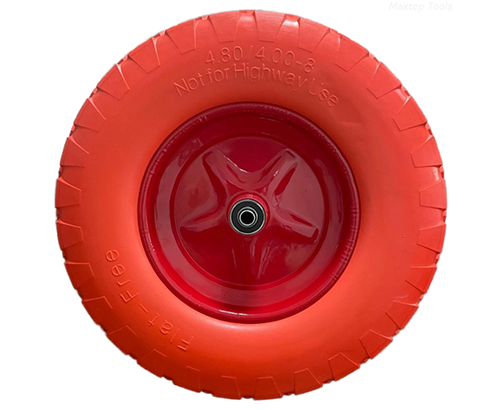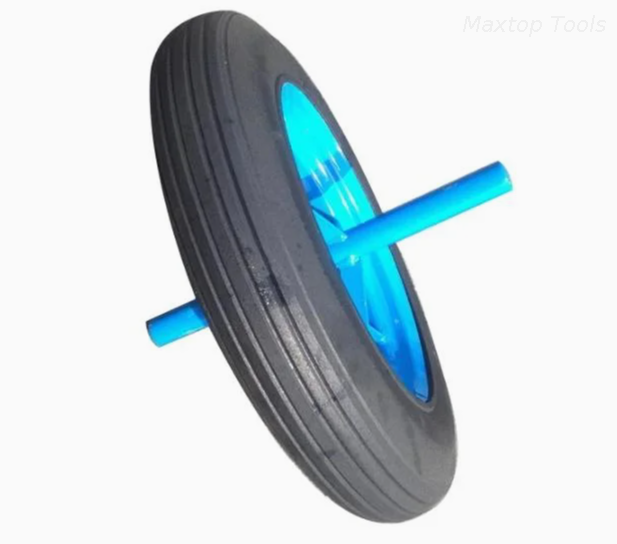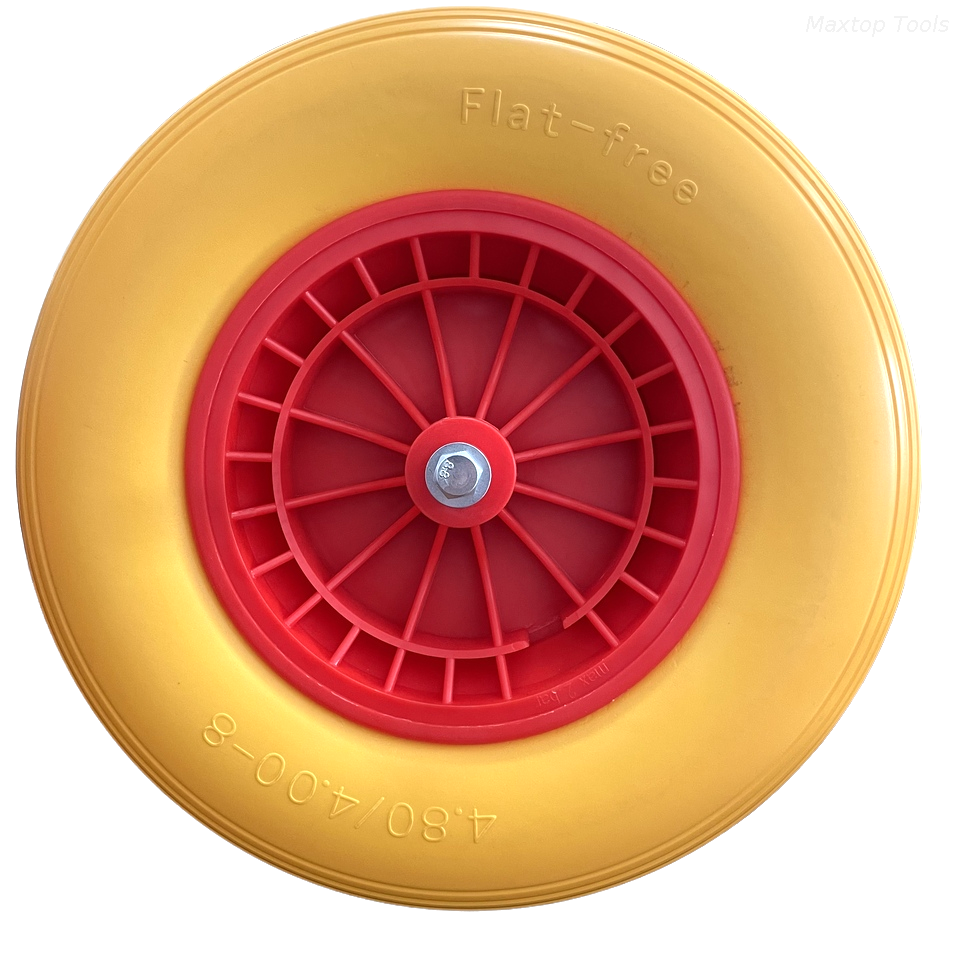
A wheelbarrow is an essential tool for various outdoor tasks, from gardening and landscaping to construction and DIY projects. The wheelbarrow tyre plays a crucial role in making the transport of heavy loads easier and more efficient. However, like all tyres, wheelbarrow tyres are subject to wear and tear, and their performance can be compromised if they deflate. Preventing a wheelbarrow tire from deflating not only ensures smoother operation but also prolongs the life of your tire. In this article, we’ll explore the different types of wheelbarrow tires, offer tips on how to prevent deflation, and guide you in choosing the best wheelbarrow tire for your needs.
Understanding Wheelbarrow Tyre Types
When it comes to wheelbarrow tyres, there are several options to choose from, each offering distinct advantages. Knowing the differences can help you select the right tire and maintain it to prevent deflation.
Wheelbarrow Pneumatic Rubber Tires
Wheelbarrow pneumatic rubber tyres are the traditional choice for many wheelbarrows due to their excellent shock absorption and traction. These tires are inflated with air, making them ideal for uneven terrains. Pneumatic tires are especially useful if you are using your wheelbarrow on rough or rocky surfaces, as they provide a cushioned ride and help to stabilize the load. However, these tires are prone to punctures and deflation, which is why they require more maintenance than other types of wheelbarrow tires.

Wheelbarrow PU Foam Flat-Free Wheels
Wheelbarrow PU foam flat-free wheels are an excellent alternative to pneumatic rubber tires. These tires are made from polyurethane foam, providing the same comfort and shock-absorbing properties without the risk of air leaks or punctures. Since the foam is solid and does not require inflation, you won’t have to worry about deflation. This makes them a popular choice for users who need a low-maintenance, reliable tire for their wheelbarrow.

Solid Rubber Wheelbarrow Wheels
Solid rubber wheelbarrow wheels are another option for users who want a tire that is durable and puncture-resistant. These tires are made entirely from solid rubber, providing excellent traction and stability on a variety of surfaces. While they don't offer the same level of shock absorption as pneumatic or foam-filled tires, they are extremely low-maintenance and can handle heavy loads without deflating or losing air pressure.

Solid PU Foam Wheelbarrow Wheels
Solid PU foam wheelbarrow wheels combine the benefits of solid rubber and polyurethane foam. These wheels are made from a dense foam that provides both durability and a smooth, shock-absorbing ride. Like solid rubber wheels, they do not require inflation, so there is no risk of deflation. They offer a good balance of performance and maintenance-free convenience, making them ideal for users who want a reliable tire for everyday use.

How to Prevent a Wheelbarrow Tyre from Deflating
Now that we have an understanding of the different types of wheelbarrow tires, let’s focus on preventing deflation. Regardless of the tire type you choose, there are several strategies you can employ to ensure your tire remains properly inflated and in good working condition.
1. Choose the Right Tyre for Your Needs
The first step in preventing deflation is choosing the right tire. If you are working in an area where sharp objects or debris are common, a solid rubber wheelbarrow wheel or a wheelbarrow PU foam flat-free wheel may be the best option for you. These types of tires eliminate the risk of punctures, meaning they won’t deflate over time.
On the other hand, if you prefer the comfort and shock absorption that wheelbarrow pneumatic rubber tires provide, you’ll need to ensure proper tire maintenance to prevent air loss. Regularly check for punctures or damage, and keep the tire properly inflated to the manufacturer’s recommended pressure.
2. Regularly Check Tyre Pressure
For wheelbarrow pneumatic rubber tyres, maintaining the correct air pressure is essential. Under-inflated tires can lead to poor performance, while over-inflated tires can become more prone to punctures. Check the tire pressure regularly, and keep a portable air pump on hand to top off the air when needed. It's also important to follow the manufacturer's guidelines regarding the appropriate pressure level for your specific tire size.
3. Inspect for Punctures and Wear
Regular inspections are vital to preventing deflation. For wheelbarrow pneumatic rubber tires, inspect the tire for punctures, cuts, or other damage that may cause air loss. Even the smallest puncture can cause a tire to deflate over time. If you spot any damage, patch the tire or replace it if necessary.
For solid rubber wheelbarrow wheels and wheelbarrow PU foam flat-free wheels, while punctures are not a concern, you should still check for any cracks or deformities in the material. Over time, the rubber or foam may degrade due to exposure to the sun, weather, or heavy loads.
4. Store Your Wheelbarrow Properly
Proper storage can help prevent tire damage and prolong the life of your wheelbarrow tire. If you live in an area with extreme temperatures, consider storing your wheelbarrow in a shaded area or inside a garage to protect the tire from excessive heat or cold. UV rays from the sun can cause rubber tires to crack or degrade, leading to deflation. Storing your wheelbarrow indoors or under a cover will help protect it from the elements.
5. Avoid Overloading the Wheelbarrow
Overloading your wheelbarrow can put unnecessary strain on the tire, leading to premature wear or potential deflation. Always check the load capacity of your wheelbarrow and ensure that you do not exceed the maximum weight limit. Overloading can cause the tire to become misshapen, leading to air leaks or tire failure. If you need to carry heavy or bulky items, consider using a wheelbarrow with solid rubber wheelbarrow wheels or wheelbarrow PU foam flat-free wheels, as these are better equipped to handle large loads without the risk of deflation.
6. Use Tyre Sealant for Pneumatic Tyres
For wheelbarrow pneumatic rubber tires, another option to prevent deflation is using a tire sealant. Tire sealants are a liquid compound that can be poured into the tire to help seal small punctures before they cause deflation. These sealants are designed to quickly seal holes in the tire as they occur, helping to prevent air from escaping. Keep in mind that while tire sealants can be helpful, they may not work for larger punctures or more significant damage.
FAQs
What is the best type of wheelbarrow tyre to prevent deflation?
The best type of wheelbarrow tire to prevent deflation depends on your needs. Solid rubber wheelbarrow wheels and wheelbarrow PU foam flat-free wheels are ideal for those who want a tire that is completely maintenance-free and won’t deflate. Wheelbarrow pneumatic rubber tires are the best choice for those who need shock absorption and traction on rough terrains, but they require more regular maintenance to prevent deflation.
How often should I check my wheelbarrow tyre for deflation?
It’s a good practice to check your wheelbarrow tire at least once a month, especially if you use it frequently. For wheelbarrow pneumatic rubber tires, checking the air pressure and inspecting for punctures or damage is essential to maintaining proper tire performance. For solid rubber or PU foam flat-free wheels, checking for cracks or wear is important.
Can a punctured wheelbarrow tyre be repaired?
Yes, a punctured wheelbarrow pneumatic rubber tire can often be repaired with a patch kit, as long as the puncture is small. For larger punctures, the tire may need to be replaced. Solid rubber wheelbarrow wheels and wheelbarrow PU foam flat-free wheels are puncture-resistant, but you should still inspect them for other types of damage, such as cracks or wear.
Are wheelbarrow pneumatic rubber tires more prone to deflation than other types of tires?
Yes, wheelbarrow pneumatic rubber tires are more prone to deflation than solid rubber or PU foam wheels, mainly because they require air to function. Punctures, leaks, and under-inflation can cause these tires to lose air and deflate. However, they offer superior shock absorption and are ideal for rough or uneven surfaces.
Conclusion
Preventing a wheelbarrow tyre from deflating requires regular maintenance and a bit of knowledge about the different tire options available. Whether you choose wheelbarrow pneumatic rubber tyres, solid rubber wheelbarrow wheels, or wheelbarrow PU foam flat-free wheels, each type has its advantages and requires a different level of care to ensure longevity. Regular inspections, proper storage, and choosing the right tire for your needs are key steps in preventing deflation. By following these tips, you can ensure that your wheelbarrow stays in top condition and continues to serve you effectively for years to come.
For high-quality tires that meet rigorous standards, Maxtop Tools offers a range of products that are designed for durability and performance. Their wheelbarrow pneumatic rubber tyres provide excellent shock absorption, while their wheelbarrow PU foam flat-free wheels offer a maintenance-free alternative. Whatever your requirements, choosing a reliable tire is essential to improving efficiency and ensuring a smooth ride on the job.
 注: 建议图片大小150px*50px
注: 建议图片大小150px*50px 

























